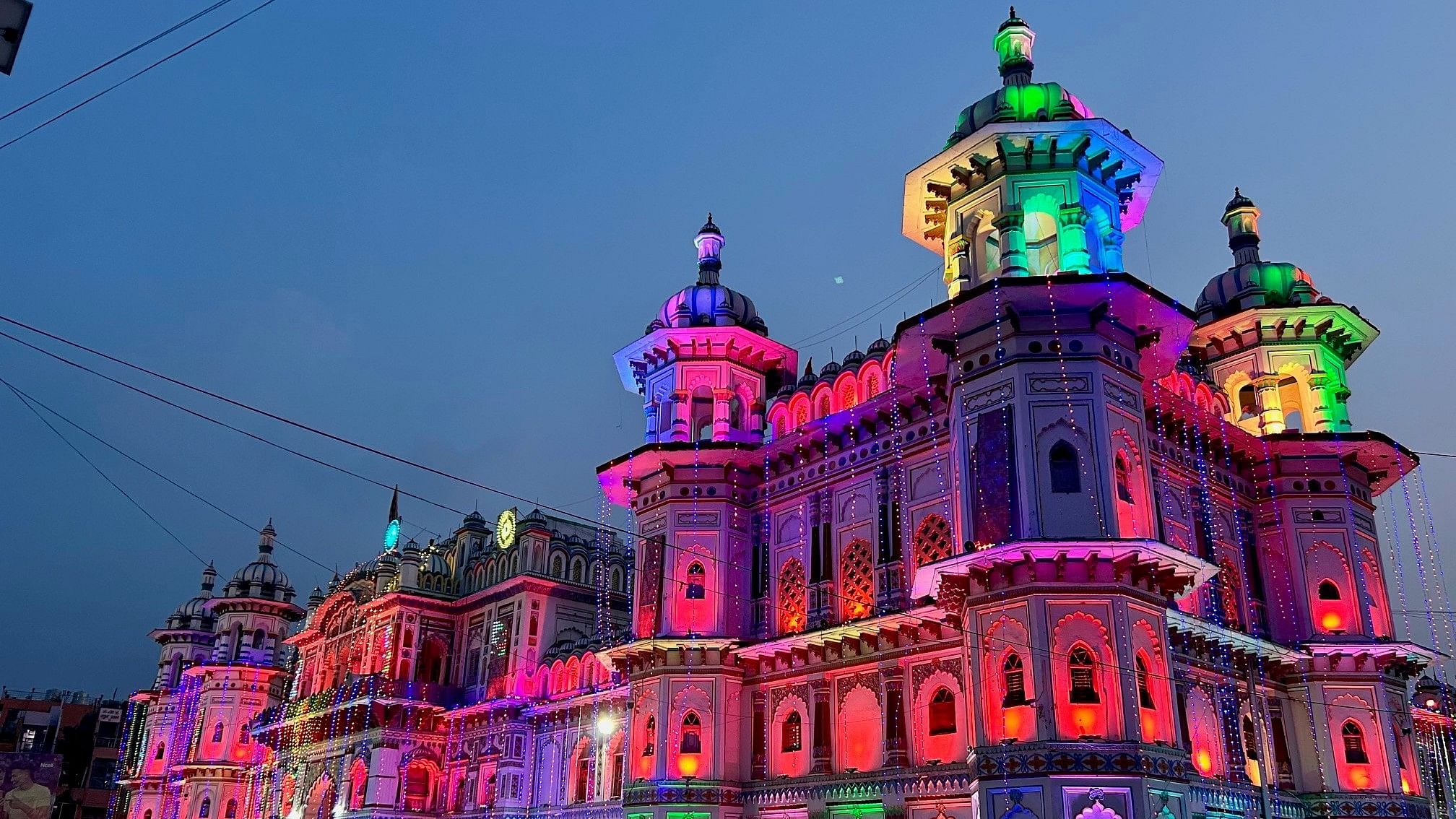
Janaki Temple in Janakpur.
Credit: Rahul Nandan
My long-cherished wish to visit Nepal finally came true this year. The Himalayan nation has always enamoured me with its diverse geography — from lush plains to the towering peaks of the world’s highest mountains. My desire to explore this beautiful land only grew stronger over time. Our 12-day itinerary included Kathmandu, Janakpur, Pokhara, and Muktinath, and I was excited to embark on this journey with my father.
The moment our plane touched down at Tribhuvan International Airport, a gentle drizzle welcomed us. The city was alive with lights as we took the first available cab to our hotel in Thamel, the bustling heart of Kathmandu.
Our exploration began the next morning. Thamel’s narrow lanes, brimming with tourists and local vendors, felt like a vibrant tapestry. Shops sold an array of souvenirs, from colourful hemp bags to traditional khukris, and numerous cafés beckoned us with the aroma of fresh coffee. The atmosphere was infectious, and we found ourselves lost in the rhythm of the city.
We ventured to Swayambhunath Stupa, a UNESCO World Heritage Site that stands majestically atop a hill. The sight of its golden tower, adorned with Buddha’s four serene faces, took my breath away. Dating back about 2,000 years, the stupa complex features Buddhist monuments and Hindu temples, reflecting Nepal’s rich cultural tapestry.
After a leisurely lunch, we visited Budhanilkantha Temple, where a colossal statue of Lord Vishnu reclines on a bed of serpents. The legend surrounding the idol’s discovery added a layer of mystique to our visit.
With a stopover at Kopan Monastery, once home to the royal astrologer, we ended our day with the darshan of Lord Shiva at the famous Pashupatinath Temple. The Shiva linga here has four faces of Shiva in four directions and it is believed that the fifth face (the top part of the linga) is invisible. The large temple complex is spread on the banks of Bagmati River, and we could not hide our dismay at the sight of its dark polluted water.
The following days were filled with more discoveries. Kathmandu Durbar Square captivated us with its old royal palaces and temples, including the famed Kumari Temple, where the living Goddess occasionally makes her appearance. In stark contrast, we found solace at Chandragiri Hills, reached via a modern cable car that offered stunning views of Mt Manaslu and the surrounding valleys. Here, we visited Bhaleshwor Mahadev Temple, where Gorkha King Prithvi Narayan Shah first gazed upon the Kathmandu Valley and envisioned his conquest.
Next on our journey was Janakpur, the legendary birthplace of Sita. Our first stop was Janaki Mandir, a magnificent temple that marries Mughal and Koiri architectural styles.
The story of the idol of Sita, found near Ayodhya, added to the temple’s significance. Nearby, the Dhanushadham Temple housed a large fossilised bow piece, said to be a remnant from Sita’s swayamvar. The town buzzed with spirituality and history, leaving a lasting impression on us.
We then flew to Pokhara, renowned for its stunning vistas of the Annapurna range. Our adventures began the next morning with a serene walk around Phewa Lake, where colourful boats bobbed gently on the water.
A short trek led us to the World Peace Pagoda, offering breathtaking panoramic views. The Gupteshwar Mahadev Cave, with its towering stalagmite Shiva linga, was another highlight, as was the nearby Davis Falls, named after a Swiss woman who tragically drowned there.
One of the most memorable moments was our visit to Pumdikot Hill, where a gigantic 51-foot statue of Lord Shiva faces in the direction of the majestic Mount Kailash. The views from the hilltop were mesmerising, showcasing the grandeur of the Annapurna range. On our last day in Pokhara, we visited the International Mountain Museum, which provided fascinating insights into the lives of indigenous mountain communities, their cultures, and the legendary Yeti.
From Pokhara, we headed to Muktinath, a revered Hindu pilgrimage site, perched at an altitude of 12,000 feet. The journey, requiring a permit due to its location within the Annapurna Conservation Area, was challenging but breathtaking. The narrow, winding roads hugged the cliffs beside the Kali Gandaki River, offering stunning views at every turn. The world’s deepest gorge awaited us, and crossing the suspended bridge over it was a thrilling experience.
As we approached Muktinath, icy winds greeted us, and the towering mountains felt like ancient sentinels watching over us. Arriving just before sunset, the landscape was painted in hues of orange and gold, an ethereal welcome to this sacred place.
The next morning, we visited the Muktinath Temple, one of the 108 Divya Desams dedicated to Lord Vishnu. The temple’s small golden idol of Vishnu radiated tranquillity, and the surrounding atmosphere was filled with a sense of peace.
Nearby, we explored the Jwala Mai temple, a Tibetan-style gompa, and admired the giant Buddha statue. The serenity of Muktinath, with its majestic mountains and the clear blue sky, was a balm for the soul. As the sun dipped below the peaks, we began our journey back, filled with unforgettable memories and experiences.
Our trip to Nepal was not just about visiting places; it was a profound journey into the heart of culture, spirituality, and nature. Each destination left an indelible mark on my heart, and as I reflect on the trip, I know that the spirit of Nepal will forever remain a part of me.